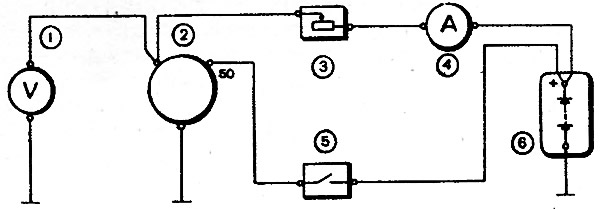The electrical connection diagram for testing the starter on the stand is shown in Figure 7-15. Connecting wires to the current source, ammeter and contact bolt of the starter traction relay must have a cross section of at least 16 mm2.

Pic. 7-15. Connection diagram for testing the starter on the stand: 1 - Voltmeter with a scale limit of at least 15 V; 2 - starter; 3 - 800 A rheostat; 4 - ammeter with shunt for 1000 A; 5 - switch; 6 - battery
The starter must be powered by a fully charged 6ST-55P battery or from a special current source, the voltage drop characteristic of which under load corresponds to the voltage drop characteristic of the battery.
The temperature during checks should be 25±5°C, and the brushes should be well ground to the collector
Health check
Closing switch 5, at a voltage of the current source of 12 V, make four starts of the starter with different braking conditions. For example, with braking torques of 1.96-2.35; 5.4-6.45; 8.8-10.6 and 11.3-12.3 Nm (0.2-0.24, 0.55-0.66, 0.9-1.08 and 1.15-1.25 kgf·m). The duration of each starter activation should be no more than 5 s, and the intervals between starts should be at least 5 s.
If the starter does not rotate the ring gear of the stand or its operation is accompanied by abnormal noise, then disassemble the starter and check its parts.
Full brake test
Slow down the ring gear of the stand, turn on the starter and measure the current, voltage and braking torque, which should be no more than 500 A, no more than 6.5 V and no less than 13.7 Nm, respectively (1.4 kgf·m). The duration of the starter activation should be no more than 5 s.
If the braking torque is lower and the current strength is higher than the specified values, then the interturn short circuit in the stator and armature windings or the short circuit of the windings to ground may be the reason for this.
If the braking torque and current consumption are below the above values, then the cause may be oxidation and pollution of the collector, severe wear of the brushes or a decrease in the elasticity of their springs, hanging in the brush holders, loosening of the stator winding leads, oxidation or burning of the contact bolts of the traction relay.
When the gear is fully braked, the starter armature should not rotate; if it does, the freewheel is faulty.
To troubleshoot, disassemble the starter and replace or repair damaged parts
Idling test
Disengage the ring gear of the stand from engagement with the starter gear. Turn on the starter and measure the current consumed by it and the speed of the starter armature, which should be no more than 35 A, respectively (60 A for starter 35.3708) and 5000+500-800 min-1 WHEN the voltage at the starter terminals is 11.5-12 V.
If the current strength and rotational speed of the armature shaft differ from the indicated values, then the reasons may be the same as in the previous test.
Checking the traction relay
Install between restrictor ring 21 (see fig. 7-13) and gear spacer 12.8 mm thick and turn on the relay. For a single winding relay, check the current consumption, which should be no more than 23 A. For a two winding relay, check the relay turn-on voltage, which should be no more than 9 V at ambient temperature (20±5) °C.
Checking mechanical data
Check the pressure of the springs on the brushes with a dynamometer, which for new brushes should be 9.8±0.98 N (1±0.1 kgf). If the brushes are worn out to a height of 12 mm, then replace them after grinding them to the collector.
The axial free play of the armature shaft should be 0.07-0.7 mm if it is not. within this limit, then disassemble the starter and select the thickness and number of shims 20 (pic. 7-16).

Pic. 17-16. Starter details: 1 - starter cover on the drive side; 2 - rubber plug; 3 - drive lever; 4 - traction relay; 5 - stator pole; 6 - series stator winding; 7 - shunt winding of the stator; 8 - rubber plug; 9 - protective tape; 10 - cover from the side of the collector; 11 - brush; 12 - brush spring; 13 - brake disc cover; 14 - body; 15 - tie rod; 16 - anchor; 17 - gear stroke limiter; 18 - overrunning clutch with drive gear, 19 - thrust washer; 20 - adjusting washer
The starter drive must move freely without noticeable jamming along the splined shaft and return from the operating position to its original position under the action of the relay armature return spring.
When turning the drive gear in the direction of rotation of the armature, the armature should not rotate. The gear must rotate relative to the armature shaft under the action of a moment of no more than 27.4 N cm (2.8 kgf cm).
